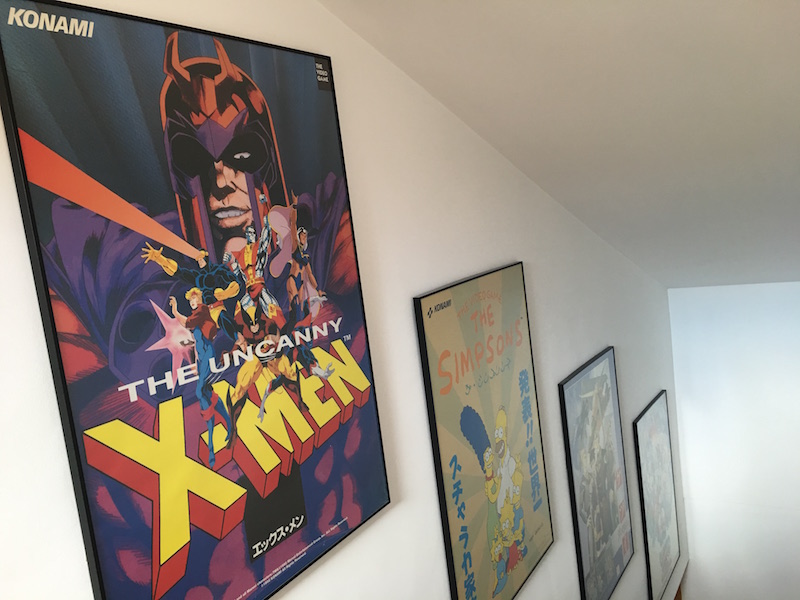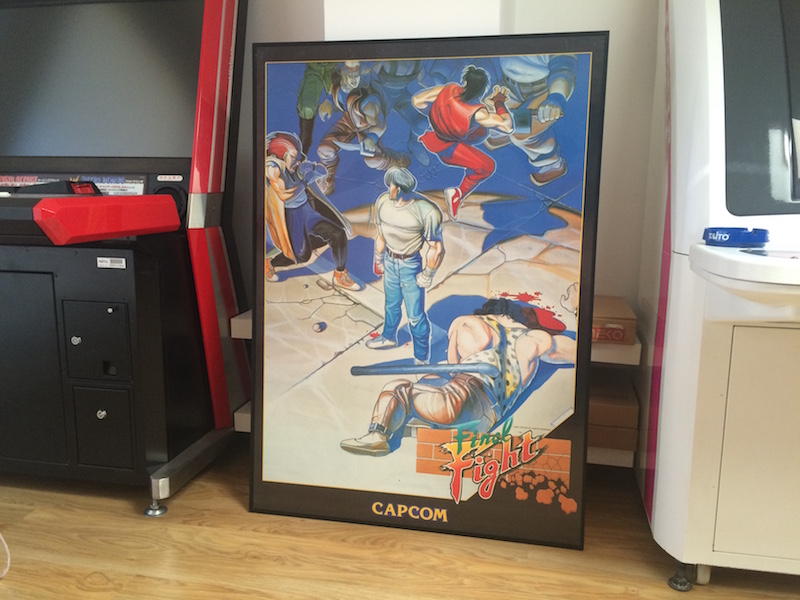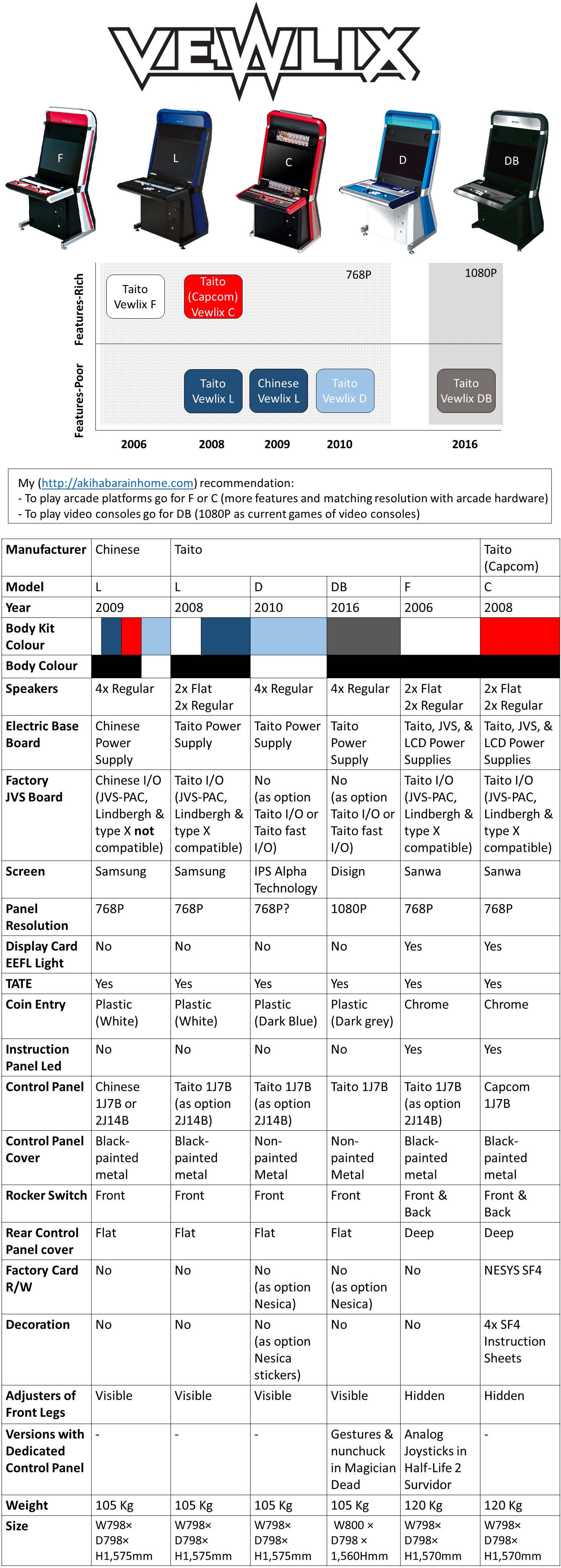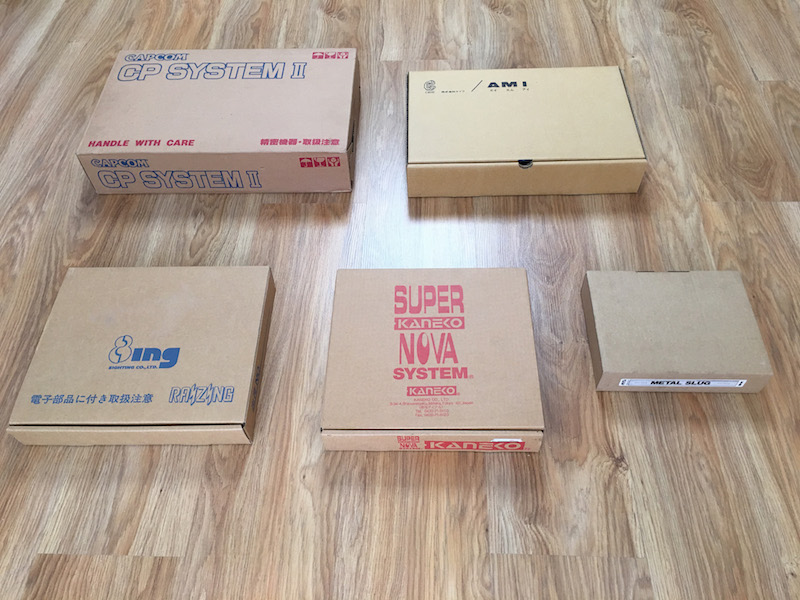| CandyCabs |
These posters of arcade games are literally pieces of arts. In my opinion, they belong in a museum (as Indiana Jones would said). They are big, B1 size, which is 707 x 1000 mm. 
|


|

|
Taito Vewlix was released in 2007, and Taito is still selling variants of the Vewlix nowadays (2018). I expect this comparison table helps you to understand the differences among all the Vewlix variants. |
Right now (June of 2014) Crimzon Clover is one of the most popular shmups at japan. The game was designed by the well-known superplayer Clover-Tac as a doujin (“indie”) game. Given the popularity of the game in the shmup community, the game made its way to an arcade release for Taito Vewlix candy cabs (Nesica system). A port of the arcade version was also released worldwide through the Steam platform as Crimzon Clover World Ignition. Crimzon Clover is a bullet hell game where the ship features a meter, the Break Gauge, that is filled by means of the destruction of enemies. Once the meter is filled, the game temporally enters a Break Mode in which the strength of the ship weapon substantially increases. It is also possible to enter a Double Break Mode which dramatically increases the strength of ship weapon.Taito Vewlix is the HD candy cab of Taito game centers at japan. The one on the youtube video is my Vewlix C (an improved Vewlix by Capcom) tated to play Crimzon Clover taking advantage of the full screen. |
|
The New Astro City and the Aero Table are plugged to the two vga outputs of an Ati X300 (CRT Emu Driver for 15khz). The first vga output goes to the J-PAC of the New Astro City, The second VGA oputput goes to the JammaSD of the Aero Table. To simultaneously output video through both vga outputs, the solution is the “force video output” option of Catalyst Control Center. The on board sound card of an ASUS P5Q Deluxe can be configured to simultaneously output front speakers sound through two 3,5 jacks. The first jack goes to the New Astro City AMP and the second one to the audio input of the JammaSD. The J-PAC and the JammaSD are chained by means of the PS2 connector to the PS2 port of the motherboard. |
SuperPlays are video recordings of memorable plays: world record scores, 1CC plays or just one amazing player controlling both player 1 and player 2 at the same time. Usually shmups developers release official SuperPlay DVDs to show strategies or scoring tricks for their games. The HDD-DVD recorder attached to the Egret II enables me to record gameplays of whatever PCB is installed in the candy cab. I believe is going to be funny to record and compare both the first and last time I play a particular PCB :-) I am also especially interested on having the possibility to record the first time one of my friends meets a danmaku shmup. I bet they will enjoy to rewatch it. This setup is inspired by the SuperPlay recording setup of the Tokyo game center “Game in Ebisen”. The SCART input of a Sony RDR-HXD890 is hook to a homemade jamma extender modified to provide a scart output. The RGB signal from the candy cab is feed to the Sony recorder without any quality loss. In addition, the Sony recorder is also plugged to the PVM to watch the recording. You can't tell that the modified jamma extender is inside of the egret II |

|
Demostration of Ketsui PCB up and running on the Taito Egret II. Ketsui is a shmup of the bullet hell category. If you don't know what bullet hell mean, I recommend you the following documental: History of Shooting Games. Stage 1 and 2 of Ketsui are not that hard, but once you reach stage 3 the game becomes really challenging. One of the main points of Ketsui is the scoring system. It is not trivial to figure out the score system to play ketsui, so my suggestion is to visit the strategy pages of your favourite shmup forum. The only thing I miss from the Ketusi PCB is the capability to keep scores when you turn the candy off. Luckily the scene is working on a save hack rom . Since it is a plug and play rom, maybe I should give it a try. |
The combination of GroovyMAME and CRT_EmuDriver is the best setup for a 15khz arcade monitor. Overall, CRT_EmuDriver tweaks the graphic card to support additional low resolutions and GroovyMAME switch to one of these low resolutions before launching the game. The goal is to run each arcade game at its native resolution. Hyperspin is just a nice frontend to select the games by means of the arcade controls. The hardware to run the games is a Core 2 Duo E8600 @ 4GHZ and a SSD. The E8600 is fast enough to run the cave SH3 games and the SSD helps to avoid the annoying sounds of regular hard disks. The candy has a push-button at the bottom to start it up (as the egret II does) and it just takes 10 second to show the hyperspin menu from cold boot. For me, it was important to keep the candy original, so no modification has been done to the stock components. The interface between the cab and the computer is a JPAC, a kick harness and the amp-up connector. |
The Sega Chihiro system has three excellent light gun games such as The House of the Dead III, Virtua Cop 3 and Ghost Squad. In addition, I also have a Naomi board ready to plug for playing Lupin 3, The House of the Dead II and Confidential Mission. Both Chihiro and Naomi boards load the games from a GD-Rom to their RAM dimm the first time you boot the games. To speed-up the booting process, boards are plugged to the network and it is possible to select which game to boot from the Hyperspin menu of the New Astro City by means of netbooting.The Upright Naomi and the gun tower is also compatible with the Sega Lindbergh system. Taking into account the nice gun games of Lindbergh (Rambo, The House of the Dead IV and Ghost Squad Evolution). I guess it is jus a matter of time to get one Lindbergh. |
Both Taito Egret II and Sega New Astro city are JAMMA cabinets, which means they have just one-for-everything connector. The Ketsui PCB has also this JAMMA connector so it is plug and play for these cabinets. To plug a regular computer to a JAMMA cabinet, it is necessary some kind of middleware that tailors the VGA, keyboard and sound connector to the pins of the JAMMA connector. This subject requires a webpage on his own, but for simplicity, I am using a JPAC middleware.The Upright Naomi is a JVS cabinet (the next version of the JAMMA standard). JVS features modern connector such as VGA, RCAs and something physically similar to USB (but no USB compatible). |



|

|
An arcade kit includes not only a pcb board to play an arcade game but also artwork to customize the candy cab. It is important to realize that most of the candy cabs are universal cabs, which means that they are produced with generic artwork about the candy itself instead of artwork about a particular game. The artwork that includes each kit depends on the game itself, but, overall, artwork compromises: manual (in this case a two side white paper), instruction card (an strip with the basic game movements to fit the instruction card space of the control panel), marquee (for the top marquee holder) and TOP (some kind of big display to attract players).The kit Dodonpachi DOJ BL is the first limited edition (approximately 100 units worldwide) released by Cave. Cave is a Japanese video game company known primarily for its shumps and DOJ BL is one of its finest shump. There is more information about the game at World of Arcades. |
The main game centers of Japan (Taito Station and Club Sega) have these ashtrays on top of the control panel of the candy cabs. The ashtrays are customized with the Sega and Taito logos and their goal is to keep the 100 Yen coins. For candy cabs with working coin mechanism these astray are a nice complement. They contribute to bring the arcade spirit at home. It is not that simple to get one of these ashtrays since game centers are reluctant to sell them. In fact, for a long time it was believed that the only way to get one was to grab (and run) them from the game center by yourself. Given the questionable source of arcade ashtrays, selling them was even banned for a time at the online arcade forums. |

|

|
Moving a candy cab is not that simple, especially if you have to go through stairs. Taito Egret II is 105kg and 1,45m, Sega New Astro City is 93kg and 1,445m and Upright Naomi is 198kg and 1,750m. For more technical details about candy cabs check out Hard Candy Cab. Almost half of the weight of a candy cab is on the monitor. However, disassembling the monitor is a tricky operation (specially in the case of the Egret II). In the case of the New Astro City and Upright Naomi, it is also possible disassemble them in a lot of pieces because they are join by screws. Unfortunately, in the case of the egret II the pieces are joined by solder.In my case, I took the safe way and disassembled as much as possible (including the Egret II monitor) to avoid any damage on the stair-climbing. |
If you think that an arcade game has no box, think again. These are the boxes of games of the following systems: CPS2, Cave, Raizing, Kaneko, Neo Geo MVS. |

|